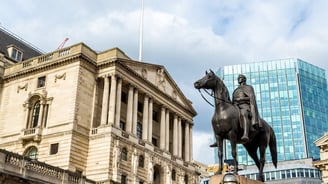Add your promotional text...
The Gilt Market Crisis: How Rising UK Bond Yields Are Shaping Economic Challenges
Synopsis: UK government bonds, or gilts, have seen a dramatic sell-off, pushing yields to their highest levels since 2008. This surge in yields creates significant challenges for the new Labour government as it attempts to balance economic recovery with mounting fiscal pressures.
MARKETSGLOBAL
By Alankrita Shukla
1/10/20253 min read


A Dramatic Sell-Off in the Gilt Market
In recent weeks, UK government bonds, commonly referred to as gilts, have experienced a sharp sell-off, sending shockwaves through the financial markets. Benchmark 10-year gilt yields surged to 4.9135%, climbing 8 basis points in a single day and reaching levels not seen since the global financial crisis of 2008.
This increase in yields signals a shift in investor sentiment and poses considerable hurdles for the newly formed Labour government, which is striving to breathe life into the struggling UK economy.
What’s Driving the Surge in Gilt Yields?
Several interlinked factors have contributed to the dramatic rise in UK gilt yields:
Reduced Expectations of Bank of England (BoE) Rate Cuts:
Investors are scaling back their expectations for interest rate reductions by the Bank of England, dampening the demand for gilts and pushing yields higher.Increased Government Borrowing:
The Labour government’s budget announcement on October 30 outlined additional borrowing plans, further spooking the gilt market and leading to a sell-off.Rising US Treasury Yields:
Across the Atlantic, US Treasury yields are climbing as President-elect Donald Trump signals a loose fiscal policy combined with higher tariffs, setting off a global trend of rising bond yields.Global Market Trends:
While yields are increasing in other major economies such as the United States, France, and Germany, the UK has been disproportionately affected, positioning it at the forefront of this global bond market adjustment.
Fiscal Pressures Mounting for the UK Government
For Chancellor Rachel Reeves, the sharp rise in gilt yields poses a dual challenge. Not only does it increase the cost of servicing the UK’s debt, but it also risks breaching fiscal rules and medium-term borrowing targets.
Goldman Sachs analysts estimate that the rise in yields has already eroded the government’s fiscal headroom, leaving it in a precarious position. “Any further rise in yields or a downgrade in economic growth forecasts from the Office for Budget Responsibility (OBR) could push fiscal headroom deeper into negative territory,” warned Goldman Sachs.
This situation could compel the government to consider corrective fiscal measures, especially if the sell-off in gilt yields continues unabated.
Economic Growth Under Pressure
The impact of rising gilt yields extends beyond government finances, creating additional headwinds for the broader economy:
Household Remortgaging Costs:
Higher yields translate into increased borrowing costs for households, particularly those looking to refinance their mortgages.Weaker Investment:
Rising interest rates deter business investment, further dampening the UK’s already sluggish economic growth prospects.
Goldman Sachs has revised its 2025 UK real GDP growth forecast to just 0.9%, significantly below consensus estimates (1.4%), the BoE’s projection (1.5%), and the OBR’s optimistic outlook (2%).
Could Rising Yields Force the BoE to Cut Rates?
While the gilt market sell-off has added to the UK’s economic challenges, it may also strengthen the case for monetary easing by the Bank of England.
Goldman Sachs predicts that a 25 basis point rate cut remains likely in February, barring any significant surprises in upcoming wage and inflation data. Additionally, further quarterly rate cuts could follow throughout the year as economic activity continues to underperform.
A Balancing Act for the Labour Government
For the Labour government, the rise in gilt yields underscores the delicate balancing act required to stimulate the economy while maintaining fiscal discipline. With growth forecasts already subdued and fiscal pressures mounting, Chancellor Rachel Reeves faces tough decisions in the months ahead.
The government will need to carefully navigate the March 26 update of economic forecasts, where any combination of higher yields or downgraded growth projections could amplify fiscal challenges.
The Road Ahead for the UK Economy
The surge in UK gilt yields has exposed the vulnerabilities of the UK economy, highlighting the interconnected challenges of fiscal management, monetary policy, and economic growth.
As the government grapples with these pressures, the decisions made in the coming months will shape the trajectory of the UK economy for years to come. For now, the gilt market remains a critical barometer of investor confidence and economic stability in an increasingly uncertain landscape.
